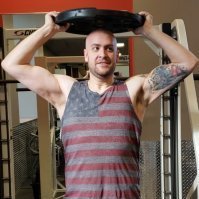Search the Community
Showing results for 'Yogurt'.
Found 17,501 results
-


Going out to eat
Vegasurvivor replied to photogirl70's topic in POST-Operation Weight Loss Surgery Q&A
I know exactly how you feel as I live in Vegas! But this is the way I looked at it. I made a lifestyle change by having surgery. Part of making healthy changes for me is giving up going out to eat. Yes, there's healthy choices rating out but its a slippery slope. And post op, very easy to push it a little and eat beyond the half cup or cup of food you should be eating. I will go to a restaurant for a special event or for business meeting ect but for the most part, try my hardest to stay away from eating out. Eating out is one of the reasons I am overweight to begin with. Even on vacation I have chose to go to the grocery store and buy yogurt, fruits, veggies ect. Sent from my Z970 using Tapatalk -


5.5 weeks out and all of a sudden full feeling is gone!!?!
Berry78 replied to carrion's topic in POST-Operation Weight Loss Surgery Q&A
If the change was sudden (overnight), you might mention it to your doc. And if it sounds normal to them, then that is great! Yogurt and liquids are supposed to go down smoothly. The restriction should be felt again when eating solids (presumably 8 weeks out). This is why they want you eating your meals and drinking only zero calorie beverages in maintenance. -
So when this journey began I started trying protein shakes for the first time. I know why I never drank them before. They are disgusting! I have wasted more money than I care to think about with cases of ready made and cans of powder still in my cabinets. Finally, I have found the perfect protein shake for me. I put one Dole Shaker, one Chobani plain yogurt and a splash of sugar free liquid. Blend it for a few seconds in the blender and presto! A little taste of heaven! 20 grams of protein and 200 calories. Tastes like a milkshake and keeps me full till lunch. Slight warning that these are not cheap. The Dole Shakers run around $2.20 and Chobani yogurt about $1.30, so you're looking at $3.50 per shake but well worth the money! Lisa
-
I have also wasted on TON of money on protein products from GNC, Walmart and my doctor's office; the ONLY one I can tolerate is the UNflavored UNjury. . . add it to o.j., yogurt, milk ---> it's great; with about 21 grams of protein in one scoop.
-


Last supper and my preop hopping spree
agirlofaith posted a topic in PRE-Operation Weight Loss Surgery Q&A
Husband took me out for sea food tonight! Was DELISH! Just got home with low carb high Protein yogurt, 2% milk, 1% cottage cheese, fruit cups in light syrup, sugar free Jello. I've got my deli meats and will go get protein for shakes tomorrow! Yay for the next 10 days!! M-W working, off thurs, Friday, off for the weekend, work Monday then have dentist in afternoon, pedicure after that. Work Tuesday and surgery is Wednesday! I'm doing this!! -


I hate to be gross but i have not had a bowel movement
boccob81 replied to Erica517's topic in POST-Operation Weight Loss Surgery Q&A
I take probiotics it helps plus yogurt . But it took a while for a bm like 3 weeks started with stool softeners then probiotics I do one or two a day -


working out and not losing weight
Essence46 replied to trulyamazingtoo's topic in Fitness & Exercise
I agree with the other commenters. This has been my struggle so I definitely understand. You aren't eating enough calories so your body is holding on to everything for dear life. LOL! Plus you are only 10 weeks out which is still early. I would suggest eating something every two hours. Yogurt. Fruit. Protein bars. Nuts. Jerky. Boiled eggs. Veggies. I know it is hard while still trying to get in your Water though. Good luck. -


Too Much? 6 days post op
Inner Surfer Girl replied to NoMoreWeightNJ's topic in POST-Operation Weight Loss Surgery Q&A
What is your protein goal? When I was on clear and full liquids I didn't go to bed until I finished all my protein for the day. If you are short of your goal by all means have another shake or yogurt. Do what it takes to meet your goal. -
I attended my last pre-op MD visit and pre op visit today which included a class on the pre and post op diet. I was expecting something way tougher based on my reading here. What I received was: PreOp: Starting 2 weeks prior to surgery date, daily diet is: -3x Nectar or Unjury protein shake -1/2 cup oatmeal or cream of wheat -1/2 cup of unsweetened applesauce -1 cup of vegetables -1/2 cup of light n fit or carb master yogurt -1 cup of low fat soup This is not an "or" list, but rather I'm supposed to eat everything on that list daily on the 2 week pre op diet. -1 day prior to surgery = clear liquids only. Curious as to why different surgeons have such drastically different requirements for the pre op diet? Also of note, for post op, they only have you on clear liquids for the first 2 days, then full liquids and purees from day 3-20, soft foods (meaning can be cut with a fork) from week 3-6, then all normal food after 6 weeks with the exception of bread/rice/pasta, which cannot have until 12 weeks.
-


to snack, or not to snack?
Pillar2butterfly replied to GSleeve822's topic in POST-Operation Weight Loss Surgery Q&A
I think it depends on how you define a "snack". I eat 6 times a day...but it's about portion size and quality of choices. My NUT wants minimum of 64 oz of Protein, but more is suggested. Example day: Breakfast: 2 hard boiled eggs or 1 scrambled egg with 1T mozz cheese. Snack (2 hours later): 6 oz Greek yogurt Lunch: tuna packet (2.6 oz) Snack: Protein Bar Dinner: Baked chicken 3 oz or so Snack: cheese stick and pickle I never eat after 8 pm I need all these in between "snacks" because otherwise I would never get in all my protein. Eating this way helps me not to snack poorly in choices. I don't think of it as snacking though, just part of my meals. If you mean snacking as in "potato chips, cake, etc" Nope...I mostly refrain entirely. -
I had surgery done on 4/14/15 it has been 6 days I want to eat everything, i feel like I'm starving. Day 1 I had only water and ice chips day 2,3&4 I had water and protein shakes, day 5 I had a little bit of Greek yogurt with some chocolate protein powder mixed in it (approx. 2oz) and some chicken broth, not at the same time, but during the day, day 6 I had 1 apple sauce no sugar added organic. 3.5 oz. I'm not sure if I'm allowed to have these things in my first week but I feel great. Keeping all fluid down and incisions are healing good. My information pack I got to refer to after surgery says I can have things that can slip through a funnel. I'm hoping what I'm doing is ok. I've tried calling my Drs office to ask but the time difference between where I had the procedure and where I live is a problem. ( I went to another state to do my sleeve). Someone please let me know if what I'm doing is DANGEROUS.
-
So true Woodkd. I could easily live on fruit/protein smoothies, lots of yogurt with pecans or walnuts stirred in (yes--way too much fat), cottage cheese, pudding. All soft stuff appeals more than going for some meat. But of course, eating all soft stuff the calorie and fat count can get clear away from me. Whereas eating some chicken or other meat--not gonna happen. Thanks for a good reminder to sometimes do the uncomfortable thing . .
-


10 Weeks Post VSG - Struggling - Eating more - Confession.
JamieLogical replied to gabrielle2014's topic in General Weight Loss Surgery Discussions
Definitely increasing your protein and fluids will help with energy. You can also probably up you calorie intake a bit. I found that in order to really sustain my workouts, I needed to be right at or a bit above 1000 a day. I also started adding a little Kashi cereal (1/4 of a serving) to my greek yogurt in the afternoons, because I found that having a little bit of carbs pre-workout really helped me get through. Then I would have a high protein dinner shortly after my workouts. I always work out in between when I get home from work and dinner. I find that's the best time for me to work out, because instead of changing out of my work clothes and into my house clothes (pajamas basically) I would change straight into my workout clothes. Once my pajamas are on, I know working out is NOT gonna happen, so by changing into my workout clothes right after work, it forces me to go ahead and do my workout! -


Can you share your good and easy to make meal favorites?
ashelaine replied to goodlady's topic in POST-Operation Weight Loss Surgery Q&A
Chicken salad, tuna salad, salmon (they have patties at trader joes or Costco and frozen filets by Gordon's are yummy)- broil them with lemon pepper, teriyaki sauce, herb butter etc and you can have one meat a million ways, chili with cheese and Greek yogurt (instead of sour cream), Atkins meals, lunch meat and cheese in 1/4 of a pita, hummus, sautéed chicken, baked chicken, I do a lot of Mexican shredded chicken and then I can make a taco, or enchilada out of it or make a quesadilla out of a flat out wrap. -


What else besides protein shakes on 6 days post op?
BLERDgirl replied to nugirl402's topic in POST-Operation Weight Loss Surgery Q&A
Your nutritionist should have given you a list of acceptable food. Eggs were not on my list until I was on purees. My first 2 weeks were full liquids. Protein shakes, cream soups, broth, water, diluted juice, greek yogurt were all acceptable. If you are unsure, you should call your nutritionist and review acceptable foods. Yes the protein shakes will get tedious, but it's only temporary. following your medical team's advice is important in the healing of your new tummy. -
So yesterday was a real bad food day for me. I am a total sneak eater. The day started off right. I had Greek Yogurt for Breakfast and a protien bar for a mid AM snack. Then came the chips. They were left overs from a work meeting and somehow they ended up in my office. The left over chips (only about a 1/4 of the bag) became my lunch...and I am not even a salt craver...chips aren't my thing but there they were so I ate them. Then no afternoon snack. So then I had to go to CVS for my meds and somehow I walked out with a box of peeps and two Reeses eggs. The eggs didn't even make it home. I ate them on my walk home and felt totally ashamed since I don't really like to eat in public since I feel like a fat person eating candy and people are watching me..even though I know that's not true its the tape that plays in my head. So for dinner I made chix w/stir fried veggies and ramen noodles...I would have been sort of ok but I ate too much...and naturally I ate all the peeps before my hubby came home. I have a total marshmellow problem and that totally hit the spot for my sweet craving...uuuggghhh! At least after that all was good and today I am totally on track again. My other issue is that I am having a hard time pooping so I have been taking laxatives to empty my tummy. I had a lax problem many years ago and all those good feelings are coming back. I'm a bit nervous about that starting up again. I hope to stop the lax by increasing Fiber and using mirilax and drinking more Water but in the meantime I'm crampy and gassy...oy...not fun while I'm at work. Anyway, I just needed to share and get that off my chest...which has gone down a full cup size btw... Thanks for listening! Peace and best wishes to all! Ally
-
Per my doc eat slowly until you feel satified. Although in the pureed stage, I was told not to worry about calories or protein, but make sure and get all my water in. Liquids went down easy for me from day one. I think I started with a 1/4 cut but it didnt take long until I could handle a 1/2 a cup. Keep in mind the diet really doesnt start until you can eat solids. Once there high cal liquids are taboo. I also found that creamed soups did not sit well. I did better on low sodium vegtable soups ran through the blender and greek yogurt.
-
Madmax68 I'm having the same issue , but I did lower my protein intake. I just a purchased this Asian yogurt at Costco called Tarte (normally can be bought at Whole Foods) the protein is 12g per serving, super creamy, light, and it doesn't have the sour tartness of Greek yogurt. I can't stand the shakes anymore!
-


Things going too well? (6 days post-op)
McButterpants replied to Jaguilar's topic in POST-Operation Weight Loss Surgery Q&A
Fluff is right on...You may not feel restriction right away. I didn't. I'm still trying to figure out what full feels like and I'm almost 2 months out. I measure and weigh religiously. Another thing is wet food vs. dense food. I was surprised to find out a couple of weeks ago that I ate 1/2 cup of chili (I was allowed to eat as much as a 1/2 cup, but had not done so to that point). I panicked - did I eat too much? How could my sleeve allow me to eat that much? Then I realized, the chili is wet and some of it probably slid thru the sleeve. The next day I experimented with chicken - I ate only chicken and could only get 1/4 cup down before feeling the restriction. The chicken was much more dense. You're probably seeing the same thing with yogurt - you'll probably be able to eat more yogurt than say scrambled eggs. My doc made of point of saying, "Eat what's on the plan in the portions you're allowed. Remember, you don't have to eat it all. Stop if you feel feel or restriction." I have found that there are times I will do a hiccup and burp at the same time, that's a clue that I'm getting full. Other times I my nose will run. Sometimes I feel a "poke" not a pain, but a feeling in my stomach. Once I feel any of these things I stop eating. You guys are doing great - it's all a learning process. Just listen to your body and stick to your portions. -


Life Changing Push
nune1974 replied to RavensAngel's topic in POST-Operation Weight Loss Surgery Q&A
In the morning I just have my protein shakes , 12:30 or 1 pm I have my launch, launch my problem I decide it from tomorrow I will have yogurt in my Lanch , I eat 2 forks salat and I'm trowing up ofter -
So, its been 16 days post op my NUT told me I was cleared for pureed foods at 12 days, I tried a VSG-friendly shepherds pie it went down ok I was sooo happy and proud I got full after like 2 bites. Yay, confirmation my sleeve is working! BUT THEN! I took a bit of low fat vanilla Greek yogurt, ONE BITE, My mother had to call 911 I was in so much pain I was on the toilet, pooping like crazy and gaging as if I had to throw up yet nothing came out, then I had a large amount of pressure all the way across my back between my shoulder blades. I was sweating and crying and so confused! There was at least a 2hour difference between the bite of yogurt and my dinner. Has anyone else ever experienced this? Also, any ideas for pureed foods would help! Thanks
- 4 replies
-
- gastricsleeve
- hunger
-
(and 6 more)
Tagged with:
-


Got my date! Dec. 10th , so excited!
hadderrie8 replied to jenmc2404's topic in PRE-Operation Weight Loss Surgery Q&A
I am on day 8 now of my preop liquid diet. It was challenging over the holiday having to attend 4 different thanksgiving dinners but I allowed myself one serving of lean meat per day and that helped. Now I am back to 6 smalls meals a day all liquid. I am allowed to have Protein shakes, cream Soups made with milk instead of Water, greek yogurt, sugar free pudding with Protein powder added, sf Popsicle, chicken broth, sf Jello, and anything to drink that has no caffeine, alcohol or carbonation. My daily meal plan usually looks something like 7:00 AM Protein shake, 10:00 AM protein shake, 1:00 PM Soup, 4:00 PM Protein Shake, 7:00 Shake or Soup, 9:30 PM Greek Yogurt. I also add in jello and sf Popsicle along with my water if I get hungry. So far I am down about 1 pound a day. -


March 2015 Sleevers
sharirose67 replied to giggleblue's topic in POST-Operation Weight Loss Surgery Q&A
I too had surgery on the 9 of March and felt the same way! Thank you for posting this! I was able to have some cream soup yesterday as well as cottage cheese and yogurt and did very well. It's definitely scary when you start eating again because you don't want to over do it. My gas pains are finally gone and I'm feeling much better today. -
These are things suggested by my nutritionist for the mushy stage: Baby food pureed fruits and veggies Low fat creamed spinach Applesauce Pureed Squash Cream of Wheat, Farina, runny oatmeal Mashed Potatoes Fish, flakey, fork mashed "wet" Tuna fish or egg salad fork mashed or blended well with low fat Mayo Non fat refried Beans Silken tofu Blended chicken or meatballs Low fat milk low fat yogurt Ricotta cheese, cottage cheese sugar free pudding Blended Soups I was craving Pasta, so made egg pastina, its small and mushy too. If I were you, I would check with your doctor/nutritionist because as you can tell by reading posts, every doctor has their own interpretation of the post opt meals and you don't want to do something he/she may not recommend, even though this is what my doctor recommended.
-


Liquid and soft food diet for veterans
ProudGrammy replied to Clementine Sky's topic in WLS Veteran's Forum
@Clementine Sky hey bud - nice to see you , sorry about circumstances. since the implants are so expensive, do you have to delay getting things "fixed"" both sides, prob!! That's terrible - are you in pain, or "inconvenience? which is still terrible. must be a funny/awful feeling. soup, cauliflower are great suggestions. "maybe" chili, cottage cheese, yogurt i agree as always, track your food in MFP but...in my opinion, since your teeth/mouth are uncomfortable - i wouldn't worry too much about calories etc (don't go crazy of course!) you have a different/sad predicament - hopefully you'll be able to fix teeth, sooner than later. keep smiling😁 hugggggs kathy











